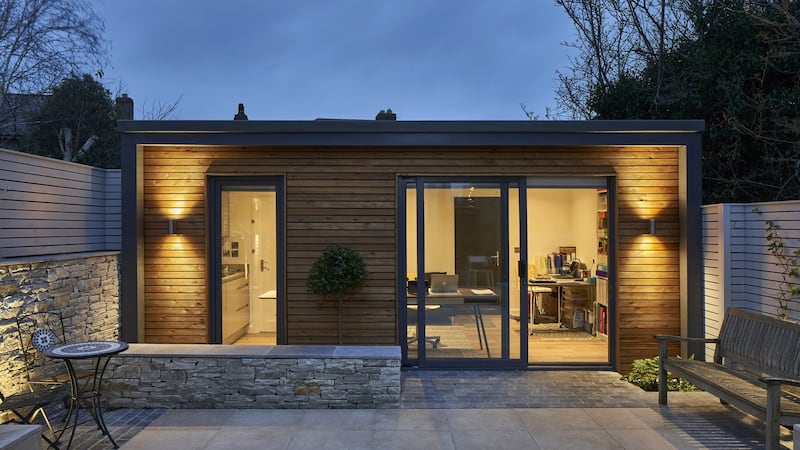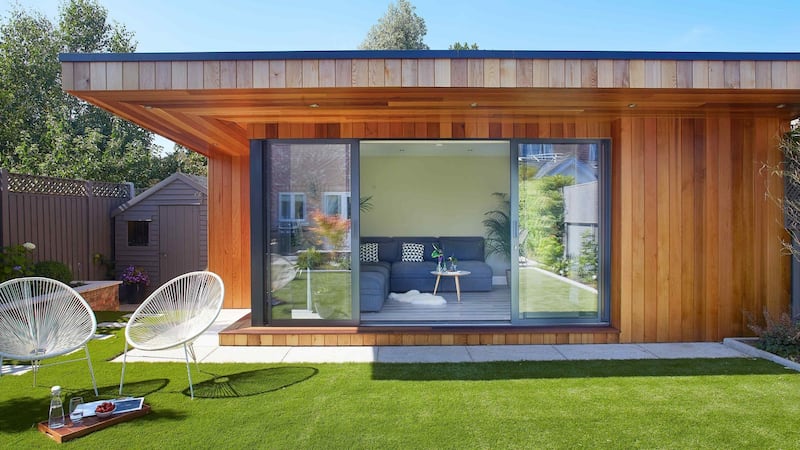Most of us have spent the past few months with work and home life taking place under the one roof while trying to put some distance between the two.
With the move to working from home, enquiries for secure, private and separate work spaces at Shomera, the original of the self-contained home office designs for the garden, increased by 400 per cent in the last few months, says managing director Frank O’Sullivan.
“For people who have spent lockdown in the attic, at the kitchen table or in a bedroom, an office in the garden gives them detachment from the house,” says Martin Maguire of Rooms Outside. “There’s no commute, but you don’t have to put away your work to make dinner.”
John Sherry, managing director of Garden Rooms, whose firm has seen an increase in visits to its website of 75 per cent during the coronavirus lockdown, says what has become important is a silent space for meetings or phone calls. "Workers need to be in a mindful place where you can close a door on work and re-enter home life."
Sherry says men have been the most proactive, with 70 per cent of his enquiries coming from them. “They see it as a genuine solution, one that currently is being prioritised over a second car or a sun holiday,” he says.
These units are designed to be smaller than 25sq m in size so they don’t require planning permission, qualifying as exempted development under planning laws. There are some conditions to their exemption, however. The garden room should not extend out in front of the building line of the house and, if installed to the side of a house, should match its external finish as much as possible. It shouldn’t exceed 4 metres in height if it has a tiled or slated pitched roof, or 3 metres if it has any other roof type. The structure may not be lived in. You don’t need planning permission to install a bathroom.

However, what you do need is a reasonably sized garden if you want to avoid having to apply for planning permission. When constructed, your garden should leave 25sq m of space in the garden. If you don't have that size garden to begin with, then you will need planning permission to construct a detached home office, no matter its size. You can find more information in a leaflet called PL5 Doing Work Around the House at housing.gov.ie.
Positioning services
Positioning and cost are the three main considerations. Positioning is important. Sherry stakes out the space so buyers can get a better sense of its scale. The direction of light is another key factor. He tries to get east or western light so the unit will benefit from solar gain. Some thought should be given to glazing too, especially if your garden backs on to a busy road, rail or tram line, and the windows are open.
You could invest in triple glazing, and air conditioning to cool you down in summer. A cable back to the main fuse box in the house will give you electricity. Getting the broadband right is also crucial – Cat 5 or Cat 6 cabling will ensure office-quality broadband. “It is better to hardwire it than to rely on wifi,” Sherry says.
Prices at Garden Rooms start from €25,000 for a timber structure with floor-to-ceiling triple-glazed glass doors, acoustic dampening and insulation, cedar cladding that needs oiling every one to two years, and a rubber-coated roof all set on concrete pads of a foundation.
Prices at Rooms Outside start from €15,254 for a 12sq m office set on galvanised steel piles. This construction minimises the disruption and will suit those living in mid-terrace homes.
“There’s no digging, no cement mixer, no mess. It can be carried through the front door,” says Maguire. His cedar-clad designs have Ecocel insulation, made from recycled newspapers and Cat6 cabling. Cedar-clad units set close to walls or fences can have those exterior sides clad in a low- to no-maintenance pvc render.
Shomera prices, which include poured concrete and galvanised steel foundations, Rockwool and polyurethane insulation, double glazing and larch cladding, range from €14,250 for a unit of about 8.5sq m to €32,950 for a 25sq m unit, including VAT.
If you have a very small space, Awnings of Ireland's CasaNova, by Austrian company Biohort, might be just the thing. This powder-coated aluminium design has smart clerestory windows and comes in a flat-pack format that can be brought through the front door, ideal if your home is terraced. The smallest size is just 6sq m and costs €9,558.99. While it includes 40mm of polystyrene insulation, that price excludes electrics and broadband cabling.
Heating in most units is electric.

Getting connected
A home office is nothing without decent connectivity. Each broadband installation is different and your connection depends on the type of broadband available in your area and the internet access product you choose. Before you invest in a swish new garden office, give your provider's customer service line a call to determine what package you're on and what might suit your working needs, says Emma Casey, head of corporate affairs at Vodafone.
“Stability is more important than speeds for most home-working activities. So a stable connection on a slower speed will serve you better than an unstable line with a higher speed. Fibre to the home is your best bet for the most stable connection.”
If you decide to go down the wifi route the location of your modem is important. Placing it in the centre of the building provides better coverage to more of your home. The speed and strength of the signal depend on the distance between the modem and the devices you’re using. Position the modem in an open space and as high off the ground as possible, on a table or piece of furniture, Casey counsels. The front of the modem (the flat side with the lights on it) should face outwards into the room. Windows, walls and anything metal can affect the signal. Avoid placing the modem behind a television or in a cabinet.
If everyone in the house is on devices using wifi at the same time it can slow its speed. Keeping devices and software up to date will ensure the best wifi experience.
Older devices may not be able to achieve fast wireless speeds.
For fibre connections, use your Eircode to see if your address, or a rural address you fancy moving to, is eligible for Siro, the venture between the ESB and Vodafone to supply fibre-to-the-building broadband with speeds of a gigabit per second across the country.
When undergoing a speed test, remember that each browser has different capabilities and may provide different results, particularly on high-speed connections. Some will process quicker than others, which will affect the result.
Software running in the background, such as virtual private network, anti-virus, content-based filtering (for example, parental control) or an active firewall may understate the performance of your broadband service.
Added value
Will a garden room add value to your home? Before the pandemic, the answer would have been no, according to Brian Dempsey, partner at DNG Stillorgan.
“Before Covid I would say that you never got your money back. Buyers didn’t value the €10,000 to €35,000 that the vendor had put into it. Its only value was the use you got out of it.” The pandemic has changed that, he says. Now it meets a specific need and has become as essential as a utility room.
“Anyone selling a property that comes with a separate, workable home office will most likely get their money back.”

















